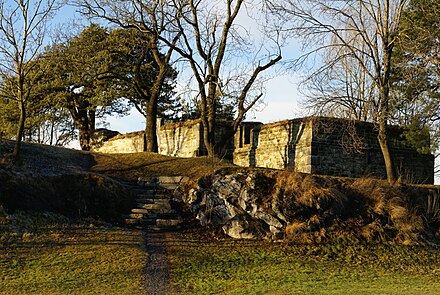Skien
Skien (Norwegian: [ˈʂêːən] (listen)![]() )[2] is a city and municipality in Vestfold og Telemark county in Norway. In modern times it is regarded as part of the traditional region of Grenland, although historically it belonged to Grenmar/Skiensfjorden, while Grenland referred the Norsjø area and Bø. The administrative centre of the municipality is the city of Skien. Skien is also the capital of Vestfold og Telemark county.
)[2] is a city and municipality in Vestfold og Telemark county in Norway. In modern times it is regarded as part of the traditional region of Grenland, although historically it belonged to Grenmar/Skiensfjorden, while Grenland referred the Norsjø area and Bø. The administrative centre of the municipality is the city of Skien. Skien is also the capital of Vestfold og Telemark county.
Skien is one of Norway's oldest cities, with an urban history dating back to the Middle Ages, and received privileges as a market town in 1358. From the 15th century, the city was governed by a 12-member council. The modern municipality of Skien was established on 1 January 1838 (see formannskapsdistrikt). The rural municipalities of Gjerpen and Solum were merged into the municipality of Skien on 1 January 1964.
The conurbation of Porsgrunn/Skien is reckoned by Statistics Norway to be the seventh largest urban area in Norway, straddling an area of three municipalities: Skien municipality (about 62% of the population), Porsgrunn (30%), and Bamble (8%). This area is home to more than 100,000 people.
Skien was historically a centre of seafaring, timber exports and early industrialization, and was one of Norway's two or three largest cities between the 16th and 19th centuries. It was also one of Norway's most internationally oriented cities, with extensive contact with its export markets in the Low Countries, the United Kingdom and Denmark. It retained its position as Eastern Norway's leading commercial city until the 19th century, when it gradually started to lose importance to the emerging capital of Christiania following the Napoleonic Wars.[3] The city was the birthplace of playwright Henrik Ibsen, and many of his famous dramas are set in places reminiscent of early 19th-century Skien.
The Old Norse form of the name was Skiða (from the word skiða which means "straight plank", and which is also the origin of the word ski), and the town is probably named after a brook (with a straight run) with this name.
The coat-of-arms is derived from the oldest known seal of the city, dating back to 1609. The seal shows two skis and in the middle a cross, with a small star on the crosspoint. The skis are a semi-canting element (based on a misunderstanding of the meaning of the town's name) and the cross is a religious symbol. There have been several theories about the meaning of the cross, but its meaning is not clearly known. It has been suggested that it is a symbol for the main church in Skien, the Holy Cross church. The small star may be a symbol of St. Mary as the second medieval church of Skien was devoted to her. Besides the skis and cross, there are two meadow buttercupson each side.
.jpg/440px-Frogner_hovedgård_-_Skien_(1).jpg)


.jpg/440px-Skien_Kirke_(tvillingetårn).jpg)
